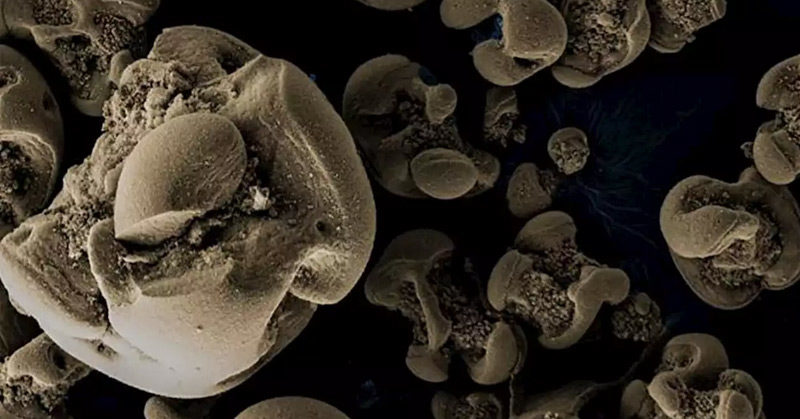Sometimes, in the world of science, researchers believe something exists, or hypothesise how something works, but are unable to gather sufficient evidence to prove it. Even to scientists, the world contains many seemingly unsolvable mysteries, and there is still so much to learn about the planet upon which we live. Scientists have suspected that there is a bacteria that eats metal for more than one hundred years, but have been unable to prove it. Finally, scientists in California have stumbled upon evidence to verify its existence, and it is providing insight to many of their unanswered questions.
An Accidental Discovery
When Dr. Jared Leadbetter, professor of environmental microbiology at Caltech in Pasadena, returned to his lab from a months-long work trip, he found an unexpected surprise. Before leaving, he had left a glass jar covered with a chalk-like type of manganese soaking in water in his sink. Upon his return, he found the jar coated in a dark material.
“I thought, ‘What is that?’ “ he explained. “I started to wonder if long-sought-after microbes might be responsible, so we systematically performed tests to figure that out” [1].
The black coating turned out to be oxidized manganese, a chemical element that is abundant on the earth. The oxidized element was generated by newfound bacteria that had likely been present in the water itself [2].
Leadbetter and his team wanted to find out if this process was actually happening due to a biological process, so they coated more jars with manganese carbonate (MnCO3). Some of the jars were sterilized using scorching steam, and some were left alone.
The manganese compound on the sterilized jars didn’t oxidize, even after an entire year, but MnCO3 on the non-sterilized jars did. That gave them a clue as to what bacteria was responsible for the metal-eating: it had to be something that could be destroyed by hot steam [3].
Read: Walking Sharks That Can Leave The Water Discovered In Indo-Australian Archipelago
A Bacteria that Eats Metal
After the initial experiment, the researchers then cultured what was on the jars. They performed an RNA analysis and found seventy species of bacteria, but were eventually able to narrow the culprit down to two possible species: Nitrospirae bacteria, and Betaproteobacterium. The former is usually crescent-shaped, and the latter is rod-shaped. Relatives of both of these bacteria are known to live in groundwater [3].
The team found that the Betaproteobacterium did not oxidise the manganese by itself, which either means that the Nitrospirae are solely responsible for the oxidation, or the two species are working together.
During their research they also found that the bacteria are autotrophic, meaning they can produce their own food using a source of energy. In this case, that energy source is manganese.
In the same way that plants use sunlight to convert carbon dioxide and water into sugar and oxygen through photosynthesis, these bacteria use the energy from manganese electrons to convert carbon dioxide into usable carbon. This process is called chemosynthesis, and while it is known to occur with other metals, this is the first time it has been observed with manganese [3].
“A wonderful aspect of microbes in nature is that they can metabolize seemingly unlikely materials, like metals, yielding energy useful to the cell,” said Leadbetter [1].
Clues to Some Unanswered Questions
Discovering a bacteria that eats metal doesn’t come without a few unanswered questions. Manganese is one of the most common elements on Earth’s surface, and is an essential human nutrient that our bodies use to process fats and proteins and form bones. Despite this, a lot of its cycle on Earth is relatively unknown.
One of the conundrums we have faced with regards to manganese is its tendency to clog water pipes.
“There is a whole set of environmental engineering literature on drinking-water-distribution systems getting clogged by manganese oxides,” Leadbetter said. “But how and for what reason such material is generated there has remained an enigma” [1].
Leadbetter explained that many scientists over the last century have suspected that a bacteria that eats manganese might be possible, but there has been no evidence to support that theory until now.
This new discovery helps scientists to better understand the geochemistry of groundwater. Scientists have long wondered how manganese oxide ends up in our water supply, and now they know that it is this bacteria that produces it.
“The bacteria we have discovered can produce it, thus they enjoy a lifestyle that also serves to supply the other microbes with what they need to perform reactions that we consider to be beneficial and desirable,” says Leadbetter [2].
This research has also shed some light in another area that has baffled scientists for years: manganese nodules that can be found on the seafloor. These round metallic balls can be up to the size of a grapefruit, and have been known to marine researchers since the 1870s. They often contain concentrated amounts of rare metals, so mining companies have been making plans to harvest and exploit them [2].
Leadbetter and his team are now wondering if microbes similar to the ones they found in freshwater are responsible for these nodules, and they plan to investigate this further. They believe that there is a need to better understand them before they are decimated by mining.
Woodward Fischer, professor of geobiology at Caltech, says that these findings fill a major intellectual gap in our understanding of Earth’s elemental cycles.
“[The findings] add to the diverse ways in which manganese, an abstruse but common transition metal, has shaped the evolution of life on our planet” [2].

